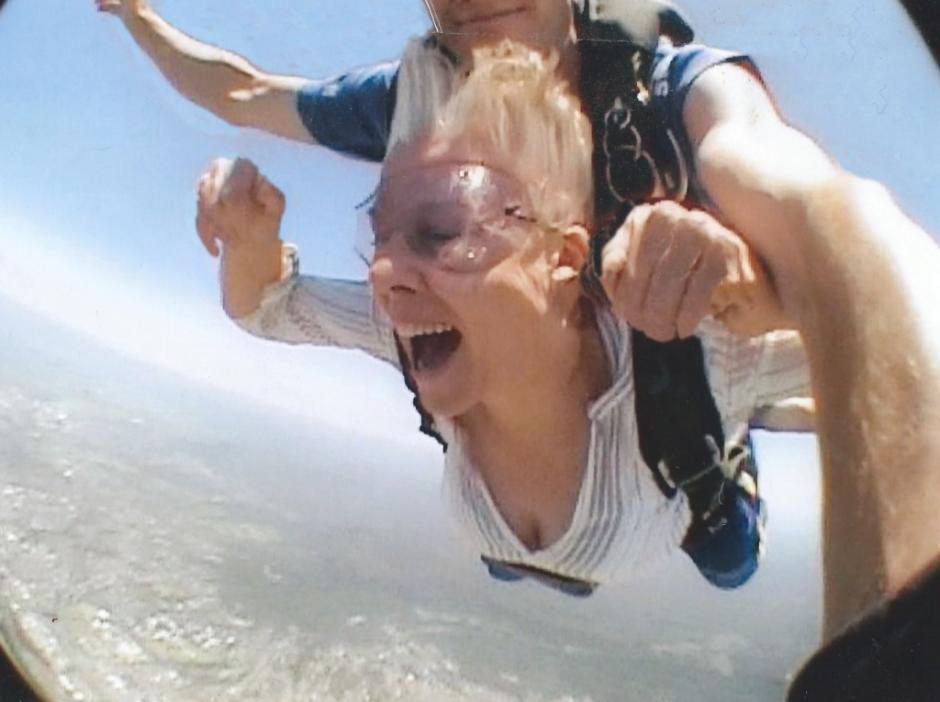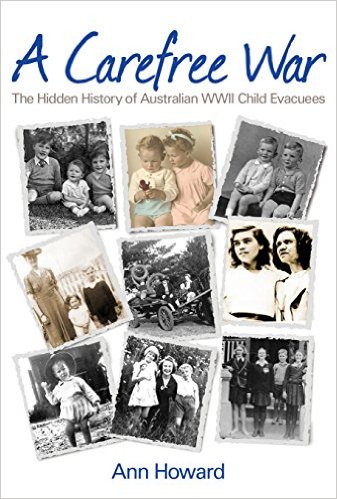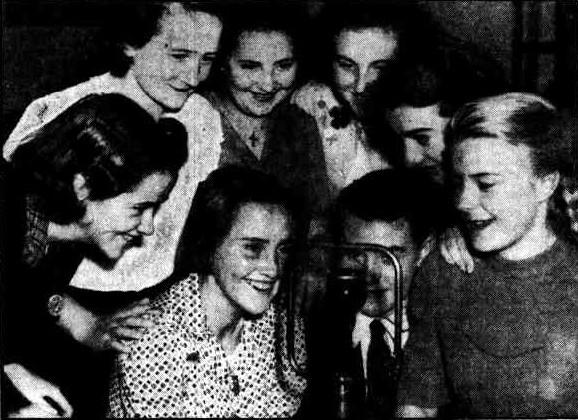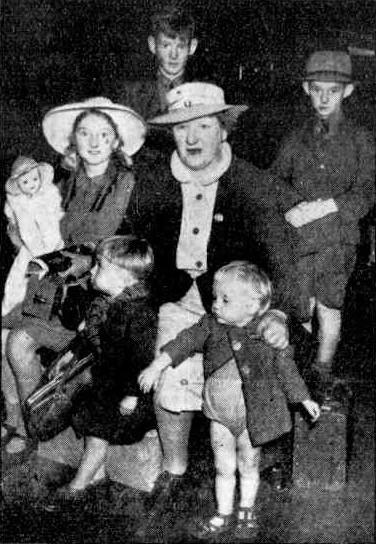September 6 - 12, 2015: Issue 230
Ann Howard

Ann Howard
In 2013 ago we ran a Notice for Australian journalist and author Ann Howard to help with a call for people she wished to talk to, or more accurately, listen to, in order to write a new book:
Ann Howard, popular author and historian on Dangar Island is collating first hand experiences of Australian child evacuees 1941-1944 for a new book Send the Children Away. She welcomes accounts and photos at: annhoward@ozemail.com.au, or phone 0299552074 or mail to Ann Howard, The Pavilion, Dangar Island 2083
Having previously run a History page on The MV Reliance, written by Ann, we were intrigued, ran the Notice and wished Ann the best of luck with her new project and asked for an update when it came to fruition.
Knowing this lady is an open and friendly individual, and that this gives her an edge in collecting stories as she will listen and let others be heard, we couldn’t wait for this new book. A few weeks ago it turned up, an extract of which runs as September 2015’s Artist of the Monthpage.
In A Carefree War, The Hidden History of Australian WWII Child Evacuees Ann, who was also evacuated with her mother, only from London during World War II, is setting the records straight. A combination of extensive research and the first-hand stories of the evacuees captures the mood of the time and the social and political environment that they lived in.
Ann is someone who loves life. An enthusiastic traveller and adventurer, she has ridden elephants through the Sumatran jungle; climbed Anak Krakatoa when part of it was erupting; made a 14,000 feet free-fall from a plane and rock climbed in Tahiti. She brings this enthusiasm to her writing and studying. She enjoys her grandchildren, her partner’s musical gift, her dogs, garden and a good single malt; not necessarily in that order.
Ann Howard lives in The Pavilion, the last structure standing of the former Dangar homes on the island named by them, a heritage house she restored. This week we delve a little deeper into one who delves deep herself, and with passion:
When and where were you born?
In London in 1942.
Did you grow up there?
Yes, most of my early life I was there. I came out to Australia in the 1970’s.
Weren’t you evacuated during WWII?
I was evacuated as a tiny child with my mother, as my father was away fighting for five years. I have memories of children with the big luggage labels on and sirens going. We did get bombed a little bit on the south coast as they jettisoned bombs coming back from London, so we got quite a lot of the war happening when we were at Eastbourne on the Sussex coast. Eastbourne is alongside Brighton, near the English Channel.
We lived at Eastbourne after the war too.
What were you doing prior to coming to Australia?
I went to Art School. I wanted to be a Painter and won a scholarship to Goldsmiths in the University of London. I was too wild though and got thrown out. I attended with Peter Greenaway the Film Producer and Ian Drury the Pop Singer – there was quite a few of our crowd who were all pretty wild and some of them have become quite famous now.
Why did you move to Australia?
I was married at that time and had two young children and my husband wanted to go to either Africa or Australia. He had a choice as he was in I.T. and was very good at what he did. I’m so glad we chose Australia as there was and has been a lot of strife in Africa.
What were your first impressions of Australia?
I didn’t know the first thing about Australia. I had this idea that there would be kangaroos hopping around. I couldn’t believe it when we landed in Brisbane and we saw skyscrapers. I just love it though and am naturalised now, it was a great choice for myself and my children.
How did get from Brisbane to living on the Hawkesbury River?
My husband died unexpectedly and when still very young. I was going to return to London with my children as I didn’t know anybody. I had a job, Teaching, but he passed away quite soon after we arrived in Australia.
Somebody invited me to a party on Dangar Island to cheer me up and I stepped off the ferry onto Dangar Island and just fell in love with it. it was September, all the jasmine was out and the beautiful colourful birds like King Parrots and Lorikeets were flying about and lemons growing on trees.
I bought this property that was so run down you wouldn’t have been able to live in it should the authorities know. There were holes in the roof, it was derelict really. The Pavilion was a place I fell in love with immediately though and having restored it now, it just looks lovely. I have people in on occasion and love showing tem around.
This building was originally a part of the Dangar Family’s property on the island and this began my delving into the history there as I couldn’t find out any information about the place, even from the Dangar Family.
In doing a lot of detective work to find out about the background of the house, which was built about 1887, I learned more and more about the island itself.
When did your writing career begin – what was the first thing you wrote?
I always loved books and don’t remember learning to read but I think I could read when I was three. I’ve always loved words and books but never thought I could be a writer until quite late in life.
I was in Melbourne, at a party, and talking to a Producer from the ABC who explained he had commissioned someone to write a play who had let him down. I asked him what the play was to be about and he said ‘Icarus and Daedalus’. I said I loved that story and it would be an easy one to do, he could do this and do that, to which he said ‘well you go home and write it’.
I went home and wrote it and it went nationwide without hardly any editing marks.
What attracted you to history works?
I’ve always loved the history stories, I loved it when still in England, and that’s partly why I loved getting an old house when I came out here because this is a young country when considering the European settlers who only have a few hundred years, and only have that relatively short of history, and having an old house is like having the best of both worlds.
Have you seen any ghosts or spirits at The Pavilion?
One ghost, once.
Do you know who it was or is?
Yes. I was in the back garden with my eldest son and it was dusk. I looked up and said to him ‘Oh, I can see a lady in a long white dress and she’s lifting up her arm and putting it on the verandah rail.’
My son, who is not afraid of anything, he has won two bravery medals, said ‘Mum! Don’t!’ and cleared off up the lane and I didn’t see him for two hours.
I wasn't frightened. I just looked and watched. The face changed as she turned and looked a little bit towards me and faded away. Two years later I invited this elderly lady in her nineties to come to tea as she’d gone to the house when she was a little girl. She brought an album with her of family photos. I opened the album and there was this lady exactly as I’d seen her, with the slim sleeves and long dress with the train and her hair up in a big curve with a knot at the top. I said I’d seen this lady and asked who it was. My visitor answered ‘It’s cousin Ruth’
I asked what happened to her and was told they used to come and visit a lot and the Royal Australian Navy men used to come down a lot and take the ladies out for picnics on the river. The lady used to go on the verandah and watch for the boats to come. She married a Captain Leewuwin and they went to Europe and had a lovely life.
I never saw her again.
Your latest book, A Carefree War, The Hidden History of Australian WWII Child Evacuees, how did this begin and develop?
Although I went to University and got two Masters Degrees I like grass roots History, I don’t like history that is politicised. I like to hear people’s voices and try to provide a platform for people’s voices. So I’m always listening for stories.
One morning and old river man came to have a cup of tea with us and during our chat he said ‘I was a rabbit boy’.
I asked what on earth is a rabbit boy and my writing antennae went up.
He said as a young boy he had been sent to a struggle farm in Oberon with his two little brothers, one in nappies, because his parents feared an invasion. I thought, 'if he was sent away, how many more children were?' I advertised for evacuee stories in the Sydney Press and I was inundated with emails and phone calls.
Originally I thought it would just be about the East Coast but once I started going through the emails and doing more research I realised this went right around Australia because they didn’t know if the Japanese were going to invade or where they were going to invade or when they were going to invade.
The men were all away fighting and Australia being and island, with most people living on the coastal fringe even then, the women were frightened for their children and sent them away, as happened everywhere, all over the world, during that conflict.
What advice would you give to any aspiring Historians – what does it take to complete a work and what keeps you going while you are?
I don’t know if I would advise anybody to be a writer as it’s very very difficult. It’s difficult to get published, there’s no money in it unless you hit the big time, so you have to do other work to support it.
Writing does have its own rewards – if you can let somebody else’s voice through or express something that touches people it’s the most wonderful feeling, so it’s very rewarding in that way, and you do meet loads of very interesting people, many of whom stay your friends, which is lovely.
For instance, with this last book, A Carefree War, people said to me ‘I wish you’d do this book because people don’t believe it happened.’
Because there was such heavy censorship during this time people just denied it happened and this is another instance of a hidden history that’s been swept under the carpet, especially if it’s about women and children.
I have done quite a few books on ‘hidden history’ and this is another reason I do like writing, to bring these stories to light.
Your books are adding to the knowledge and information on Australian history, something we are now more hungry for – what is your perspective on doing such work?
I like the 1940’s and feel comfortable about writing of the 1940’s – I think it’s a fascinating time. Te feedback from readers is that they are enjoying it, they think it’s fantastic and it’s also going like hotcakes. It also makes plain that World War Two history isn’t complete without the story of the evacuation as thousands of people were involved, not just one or two, and they made up their own minds to go, something which I think is very significant.
What is your favourite place in the Broken Bay – Hawkesbury - Pittwater area?
That would be hard to say as I just adore the whole river, I just love it. Watching the changing light, going down the little inlets and exploring, everything is so beautiful. It has its own definite character because it’s such a mighty river, the lower and the upper are so different while Pittwater is different again – it’s like saying what your favourite colour is really.
What is your favourite colour?
I don’t know! (laughs)
What colour are you wearing now?
Rainbows!
What is your motto or life or a favourite phrase you try to live by?
Take life in both hands, think big, and never miss an opportunity.
A Carefree War, The Hidden History of Australian WWII Child Evacuees
 ‘In every coastal city in Australia this last fortnight, one question has run like a refrain through the news and rumours of war. It is: What are we going to do about the children?’ — The Australian Women’s Weekly, December 27, 1941
‘In every coastal city in Australia this last fortnight, one question has run like a refrain through the news and rumours of war. It is: What are we going to do about the children?’ — The Australian Women’s Weekly, December 27, 1941
During World War II Australia was under threat of invasion. Could Australia be invaded by the Japanese? Even with the heavy censorship by the government many certainly thought so and the nation was gripped by fear that the danger would soon be on their doorstep.
The Japanese appeared to be looming closer; there were submarines in Sydney Harbour, Japanese planes flying overhead and harassment on our coastline. Australians were fearful for their safety. Anxious parents made decisions to protect their children, with or without government sanction. Small children were sent away, often unaccompanied, by concerned parents to friends, relatives, or even strangers living in ‘safer’ parts of the country.
Some had little comprehension of what was happening and thought they were going on holiday to the country.
The history of these child evacuees in Australia remains largely hidden and their experiences untold. Author Ann Howard, who was evacuated with her mother from the UK during World War II, has set the records straight. A combination of extensive research and the first-hand stories of the evacuees captures the mood of the time and the social and political environment that they lived in.
Unlike the sometimes sad and horrible experiences of their UK counterparts, for many Australian child evacuees there enforced ‘holiday’ was a surprisingly happy time.
A Carefree War tells the story of the largest upheaval in Australia since white settlement using oral memoirs and box camera photos, all placed within the frameworks of history. The voices of over one hundred contributors join together to paint a vivid picture of wartime Australia; the fear, the chaos and civilians floundering under the impact of a war that would change their way of life forever.
___________________________
Available at Big Sky Publishing www.bigskypublishing.com.au $24.95
For a signed copy email Ann Howard annhoward@ozemail.com.au
Read a sample at: http://www.amazon.com/dp/B013AR18N2
Copyright Ann Howard, 2015.
Payments For Children Evacuated
MELBOURNE. Monday.-The scale of weekly payments' which must be made by parents of children transferred to safe areas under the Government scheme was announced today. Weekly rates will be- a Mother or female guardian with one child under two, 24/; other children under six,;8/: each child six to nine, 11/: each child 10 to 15, 13/; each mother or female guardian accompanying children, 15/. Payments For Children Evacuated. (1942, March 17).Newcastle Morning Herald and Miners' Advocate (NSW : 1876 - 1954) , p. 3. Retrieved fromhttp://nla.gov.au/nla.news-article140411488
Evacuated Children
Of 479 children evacuated from Britain who will arrive in Australia shortly, 347 will go to homes in N.S.W. and Victoria, according to the-Minister for the Interior; Senator H.U. Fell. He pointed out that the ship would not call at Adelaide or Brisbane, land consequently children going to homes in Queensland, South Australia and Tasmania would have to be transhipped. Quotas for States other than N S.W. and Victoria would be greater from subsequent shipments, he said. Senator Fell said that 251 boys and 228 girls, whose ages ranged from five to 15 year would arrive in the first ship. The parents of 880 of them had given the names of prospective guardians, but it should be understood that these children were not officially nominated. The British Government has made arrangements for the care and welfare of the children on the voyage to Australia and on arrival here their placing in suitable homes will be made by the various State Governments on behalf of the Commonwealth ' said Senator Fell. The State Governments would communicate with those people whose names had been furnished by the childrens' parents, and those Australians who had nominated children arriving on the first ship. Evacuated Children. (1940, August 28). The Scrutineer and Berrima District Press (NSW : 1892 - 1948), p. 3. Retrieved from http://nla.gov.au/nla.news-article123712762
Spoke to Families Overseas

Children evacuated from Wales and England gather about the microphone at 2NC Newcastle yesterday to speak to their families by radio telephone Spoke to Families Overseas. (1942, April 30). Newcastle Morning Herald and Miners' Advocate (NSW : 1876 - 1954) , p. 1. Retrieved from http://nla.gov.au/nla.news-article140420094
Committees Form In Coastal and Inland Centres
AS war approaches Australian shores, the work of evacuation goes on steadily. Mothers are taking their children far from the coast to country centres where they are gradually settling down in their hundreds. Other mothers are sending their little ones in the care of Government employees hoping that soon they will be able to join them. .With true hospitality the country is welcoming them.
School children are receiving unit consideration and the Teachers' Federation Is engaged in devising ways and means for emergency transplanting of youngsters to safe zones. 'More than 6000 teachers have voluntarily offered their services to 'help the Government'.They propose the appointment of a central evacuation committee, consisting of a representative each of the Departments of Education, Transport, and Health, the evacuation branch of the NJJ.S. Department, and the Teachers Federation, to co-ordinate all evacuation processes. Also the adoption of group evacuation as the general principle and the evacuation of of school and preschool children. .Maintenance of the school as a unit with books and equipment, so far as possible, Teachers to be allotted to specific small groups of evacuees and to study special conditions hi the mass evacuation areas, To act as liaison officers between the local and centre committees. To supervise the organisation of sustenance, laundering, and other services.
The British Settlers' Welfare Committee has evolved an evacuation scheme in co-operation with Moree municipal council. Moree has formed Its own special committee and a representative has been sent to Sydney to interview parents who wish to be voluntarily evacuated. Accommodation has already been found for a large number of families, most of whom are evacuees from New Guinea, Darwin and Malaya. The majority of accommodation arranged at Moree is of the 'paying guest' variety, weekly tariffs being quoted at 35/ for adults, £1 for children, and 10/ for children aged less than five years. Evacuees must do their own laundry and look after their rooms, Originally the scheme was planned for evacuees from the Far East war zones, but Sydney women who wish to be evacuated with their children can also take advantage of it through the Child Evacuation Committee. Well-known station owners on properties near Moree are supporting the Evacuation Committee’s accommodation plans. A lovely station homestead In the district has been offered to the committee at a weekly rental of £10. The committee proposes to let the homestead to four or five families, and permit the mothers to arrange their own community life. Other homesteads close to the town area also being considered. Plans for the evacuation of people from coastal centres voluntarily or under compulsion are being advanced, At a meeting of Lismore Evacuation Committee it was considered unlikely that Lismore would be asked to provide for accommodation of evacuees from other centres, in view of the fact that the government had not decided on the areas to which people were to be sent, the committee was not ablo to complete its plan. The district inspector of schools has undertaken to secure the names of children and parents and a was suggested that wardens, in addition to securing in. Regarding accommodation available In the event of this being required regarding Invalids and aged persons. Evacuation Work Goes On. (1942, February 5). The Farmer and Settler (Sydney, NSW : 1906 - 1957), p. 12. Retrieved, from http://nla.gov.au/nla.news-article117172423
Children's Home Evacuated
Inmates of the Far West Children's home at Manly have been evacuated to Springwood, according to advice received at the last meeting: of the Armidale committee which supports the scheme. .This, and other influences of war conditions have meant increased financial burdens for organisers of the scheme, and the Armidale committee intends making a special effort to assist in this task. FAR WEST SCHEME. (1942, March 6). The Armidale Express and New England General Advertiser (NSW : 1856 - 1861; 1863 - 1889; 1891 - 1954), p. 4 Edition: FINAL EDITION. Retrieved from http://nla.gov.au/nla.news-article193156312
NEWCASTLE CHILD EVACUEES

The first batch of Newcastle children to be evacuated under the voluntary system on their way on Saturday, with their escort, Mrs. Donoghue. In front are Jimmy and Brian Dobson; behind, Morris and Roland Bull, and, with doll, Helen Bull. NEWCASTLE CHILD EVACUEES. (1942, March 23). Newcastle Morning Herald and Miners' Advocate (NSW : 1876 - 1954) , p. 4. Retrieved fromhttp://nla.gov.au/nla.news-article140405327